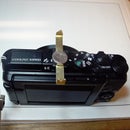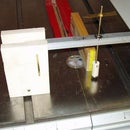Introduction: Vacuum Cannon Drives Ping Pong Ball at Supersonic Speed
Here I will describe a cannon that can drive ping pong balls fast enough to go through plywood and aluminum cans. This "vacuum cannon" has been demonstrated in college physics classes, since it involves many basic physics concepts such as Newton's laws of motion, air pressure, and particle dynamics. There are some great videos online of these college class demonstrations, but details of construction are a bit sketchy. Some sources claim achieving a ping pong ball speed well over the speed of sound (340 m/s, or 760 mph), but others perform a mathematical analysis that indicates a limiting speed of about 280 m/s ( 625 mph). I made a ballistic pendulum and conducted many speed measurement tests, my average speed was 378 m/s (845 mph). So I am going to claim supersonic speed, and admit there is some controversy.
So here is the warning: At this speed, even a ping pong ball is very dangerous. We are talking about a projectile travelling as fast as rifle bullets. If you elect to build this device, you must treat it with respect and use appropriate safety measures. These include:
Set it up so nobody can be in front or behind the cannon.
Wear safety glasses and eye protection.
Do not put any part of your body in front of or behind the cannon.
Also - the cannon can and will fire at unexpected times, especially as you experiment at the beginning.
Step 1: How It Works
The "cannon" is basically a 6 foot length of 1 1 /2" PVC pipe. A ping pong ball is placed at the near end, and both ends are sealed with thin plastic or aluminum foil. The air is then evacuated from the pipe with a vacuum pump. When the seal at the near end is ruptured, air at atmospheric pressure rushes into the pipe and propels the ball through the seal at the far end.
The key concept is that the ball travels through a vacuum in the pipe, therefore there is no air resistance. With full atmospheric pressure on one side of the ball and no resistance on the other, the ball initially accelerates at about 5000 g's.
The photo shows the setup.
Step 2: Parts and Tools
The only big ticket item is the vacuum pump. The one I bought cost about $100. The higher the vacuum, the better the results. Ideally, it should be a two stage pump. Many vacuum pumps are available on EBay; they are commonly used in the refrigeration trade.
Also:
Safety glasses
Hearing protection
Six foot length of 1 1/2" PVC pipe, schedule 40 (important)
1 1/2" PVC pipe coupling
Thin plastic and aluminum foil.
Vacuum tubing and fittings, I used 1/4" size.
Vacuum gauge (optional).
Ping pong balls, a lot of them. Be sure they are standard 40mm (1.57") diameter. There are 38mm ping pong balls out here; they will not work nearly as well.
Basic shop tools, nothing special.
Step 3: Make the Seals
This part is tricky; the seals have to be perfectly air tight, yet rupture when cut - not leak slowly. They wiil go with a bang when they are right.
There are several methods. to make the seals, I will list what worked best for me.
Best is to sandwich foil between two squares of 1/4" plywood or MDF. I cut a 2" hole at the center of the squares. Then clamp together with spring clamps. I use this seal on the near end.
On the far end, I stretch the foil over the 1 1/2" pipe, then press a 1 1/2" PVC coupling over it, tightly. Wrinkles are bad, they can cause small vacuum leaks or premature rupture. When the vacuum pump is active and seals in place, expect premature ruptures at any time, at either end!
I used "Basket Wrap" plastic foil, available at fabric stores, for the far end seal, and now use aluminum foil for the square seals shown below. You can use plastic foil as in the photo, but I have found that aluminum works best and produces the highest speed.
The flat square seals work best. With the vacuum pump on, just hold the seals to the pipe end and vacuum will do the rest.
Step 4: Prepare the Cannon
Install a hose fitting near one end of the pipe (the near end). I used a 1/8" NPT x 1/4" hose barb brass fitting. It must be air tight.
Sand ends of the pipe flat and smooth.
Connect 1/4" tubing between vacuum pump and fitting on pipe. A valve may be needed depending on the type of pump; my pump came with a shut-off valve.
Step 5: Fire the Cannon
1. Place the ping pong ball at the "near" end, just in front of the seal.
2. Place seal at "far" end (see photo in step 3).
3. Set up a target, aluminum pop cans for instance.
4. Put on safety glasses and hearing protection.
5. Turn on vacuum pump.
6. Hold square seal up to the near end pipe opening. Vacuum will grab it and pull it tight. Two photo shows two types of "near end" seals in place, being held by vacuum. I now use aluminum foil here.
7. Wait until maximum vacuum is attained, then puncture the near end seal. There will be a loud bang.
The main photo shows a firing when the ball easily went through an aluminum can. With maximum vacuum of nearly 30" mercury, the ball will just as easily go through two cans. The other photos show the near seal under full vacuum.
Remember - these seals can rupture unexpectedly during this step.
Step 6: Speed Testing
Since I earlier made rash claims about shooting ping pong balls at supersonic speed, I need to describe how these speeds were measured.
I made a "ballistic pendulum"; a device once used to measure muzzle velocity of rifle bullets, but now mainly used in physics classes to demonstrate the principles of conservation of momentum and energy. The projectile is shot into a block, and is retained inside the block. The block + projectile then swing due to the momentum of the projectile. The vertical height gain of the block is measured, and when multiplied by the mass of the block + projectile, represents potential energy increase. Using the following equation gives the velocity of the projectile:
Velocity = (m+M)/m (√2gh)
Where:
m = mass of projectile, in kilograms (ping pong ball mass = 2.7 g = 0.0027 kg)
M+m = mass of projectile + block, in kilograms (1.32 kg)
g = acceleration of gravity, 9.81
h = vertical height gain, meters, less height gain from air only tests. (2.5 cm = 0.025 m)
The numbers in parentheses are the average values from my tests.
Calculation using above values gives the ping pong ball velocity of 342 m/s. Speed of sound at sea level is 343 m/s. Studies (https://physics.csuchico.edu/~eayars/publications/AJP00961.pdf) have been made which show that theoretical velocity can not exceed speed of sound.
“A ballistic pendulum is a device for measuring a [projectile's] momentum, from which it is possible to calculate the velocity and kinetic energy. Ballistic pendulums have been largely rendered obsolete by modern chronographs, which allow direct measurement of the projectile velocity. Although the ballistic pendulum is considered obsolete, it remained in use for a significant length of time and led to great advances in the science of ballistics. The ballistic pendulum is still found in physics classrooms today, because of its simplicity and usefulness in demonstrating properties of momentum and energy.” (From Wikipedia).
Photos below show the ballistic pendulum I made (along with a view of my screwdrivers and chisels).
The lines on the panel in the background are to measure height, in centimeters.
The laser pointer shows height of the block. In the photos, the first shows height before firing, the second shows maximum height attained after firing. A video camera records the action.
The last photo shows the ping pong ball caught in the block.
In addition to momentum from the ball, there is momentum transferred to the block from the air exiting the cannon. I made test runs using air only and subtracted this average height (0.03 cm) from the tests with ping pong balls.

Participated in the
Epilog Challenge V













